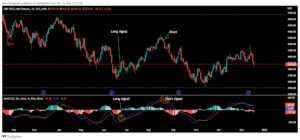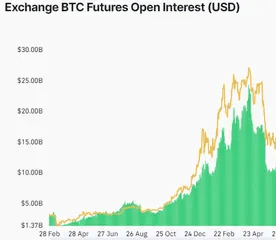Trading in financial markets can be both challenging and exciting. Traders use different strategies to make money. It requires a combination of instinct, analysis, and tried-and-true strategies. In the world of financial markets, where every tick of the clock brings new opportunities and challenges.
Whether you’re a seasoned trader or just dipping your toes into the market waters. If you have a solid understanding of effective trading techniques can make all the difference.

In this complete guide, we will see the variety of trading strategies that cater to different market conditions and trading styles that will empower you to navigate the markets with confidence and skill.
This article goes into three of the most effective trading techniques, providing significant insights to traders of all experience levels.
1. RSI + MACD Divergence
The Relative Strength Index (RSI) and Moving Average Convergence Divergence (MACD) are reliable for technical analysis,. They prized for their ability to identify changes in market momentum. When used together to detect divergences from price movements, these indicators can provide valuable insights into potential trend reversals.
Entry/Exit Criteria:
- Recognize constructive and optimistic divergences in price, RSI, and MACD.
- Use RSI crossings above 30 and dips below 70 as entry signals.
- Implement stop loss and take profit levels based on recent swing highs or lows.

Entry:
Conflict in RSI and MACD: A positive divergence occurs when the price makes a lower low while RSI and MACD make higher lows. In contrast, a bearish divergence occurs when the price achieves a higher high while the RSI and MACD reach lower highs.
RSI movement: An entry signal is generated when the RSI rises above 30 (indicating potential upward momentum) or falls below 70 (indicating potential downward momentum).
Stop Lossing Money:
l For a constructive divergence, traders typically place a stop loss just below the latest swing low or support level.
l For an unfavorable divergence, the stop loss is often set slightly above the most recent swing high or resistance level.
Earn Money:
To close a position, traders should consider taking profits when the RSI returns to the 50 level or the MACD crosses the signal line.
Why This Strategy is effective?
The synergism between RSI and MACD serves as a powerful confirmation tool, It offers the traders a reliable signal of diminishing trend and possible trend reversal. By taking advantage of these early warning signs, traders can enter trades with confidence and precision.
2. Returning to Resistance/Support:
Technical analysis relies heavily on understanding support and resistance levels. These levels are crucial regions to keep an eye on . They reflect price points where the asset has historically been subject to buying or selling pressure.
When the price breaks through these levels and then retraces to test them, traders can profit from the market’s attempt to confirm or challenge the breakout. Many people favor this price action technique since it is easy to implement and repeat
Entry and Exit Criteria
Entry: The price should return to the previous resistance level after a bullish breakout. If this resistance-turned-support level persists, it indicates that the breakout is legitimate and that the price will likely continue its upward trend.
Exit: After a bearish breakout, the price should retrace to its previous support level. If this support-turned-resistance remains, it signals that the breakout was real, and the price may continue to fall.
Traders might profit from market moves away from previous support or resistance levels after a retreat.
Why Is This Approach Effective?
The market basically uses a pullback to support or resistance as a means of validating and reassessing its initial breakout decision. If resistance is broken and successfully tested as new support, this reinforces the market’s optimistic sentiment. This self-confirmation increases belief in the breakout’s genuineness, allowing traders to enter the trend with greater confidence
3. HMA combined with stochastic
The Stochastic Oscillator and Hull Moving Average (HMA) together provide a useful toolkit for traders. Before we get started with the technique, let me briefly describe both indicators.
The stochastic oscillator is a momentum indicator that compares an asset’s closing price to a range of its prices over a given period. Levels above 80 usually indicate that the asset is overbought, whilst levels below 20 indicate that it is oversold.
Hull Moving Average (HMA): A sort of moving average that reacts more quickly to price fluctuations than regular moving averages. It lowers lag and improves responsiveness, making it ideal for short-term trading.
This approach works best when trades are made in the direction of the broader trend.
Entry/Exit
To enter, ensure the Stochastic Oscillator is either overbought (>80) or oversold (<20). When the Stochastic falls back below 80 or rises above 20, it suggests a possible momentum shift.
Subsequently, if the 9-period HMA (blue) crosses over the 21-period HMA (red) shortly after, this confirms the trend reversal.
For an uptrend, the 9-period HMA crossing over the 21-period HMA confirms a purchase signal at the candle’s closing. In contrast, during a downtrend, the 9-period HMA crossing below the 21-period HMA confirms the sell signal.
To properly control risk, traders generally set stop losses just above or below nearby swing points for short and long bets, respectively.
How to make profit?
To take gains with the Stochastic + HMA method, traders might look for signals of trend exhaustion or a reversal in the Stochastic Oscillator.
Why Does This Approach Work?
The basic function of the Stochastic oscillator is to identify overextended market circumstances. It, like all other indicators, can produce erroneous indications when employed in isolation. However, when combined with the faster-reacting HMA, the Stochastic’s early warning is validated by the HMA. The 9-period HMA responds quickly to price movements, while the smoother, lengthier 21-period.
In conclusion, these methods might help traders who are interested in trying out different sorts of stock trading.
They are not confined to stocks; you may find the same repeating trades in the FX, commodities, and cryptocurrency markets. However, keep in mind that the techniques are only a framework and should be customized for each trade.
Remember: In crypto, knowledge is power.
Join the conversation! What’s your take on the trading strategies? Share your thoughts below!
Disclaimer: This article provides general information and does not constitute financial advice. Always do your own research and consult with a professional before making investment decisions.












